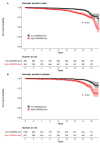Independent association of thigh muscle fat density with vascular events in Korean adults
- PMID: 38281946
- PMCID: PMC10823598
- DOI: 10.1186/s12933-024-02138-w
Independent association of thigh muscle fat density with vascular events in Korean adults
Abstract
Background: We aimed to explore the associations between thigh muscle fat density and vascular events.
Methods: A total of 3,595 adults (mean age, 57.2 years; women, 1,715 [47.7%]) without baseline cardiovascular events from the Korean Atherosclerosis Study-2 were included. Muscle and fat area at the mid-thigh level were measured by computed tomography (CT) using the following Hounsfield Unit range: 0-30 for low density muscle (LDM); 31-100 for normal density muscle (NDM); and - 250 to - 50 for fat.
Results: During a median follow-up period of 11.8 (4.3-13.9) years, vascular events occurred in 11.6% of men and 5.9% of women. Individuals with vascular events had a larger LDM area (men: 48.8 ± 15.5 cm2 vs. 44.6 ± 14.5 cm2; women: 39.4 ± 13.2 cm2 vs. 35.0 ± 11.8 cm2, both P < 0.001) compared with those who did not have vascular events during the follow-up of at least 5 years. The LDM/NDM ratio was also independently associated with vascular events after adjusting for cardiometabolic risk factors. Moreover, the LDM/NDM ratio improved the prognostic value for vascular events when added to conventional risk factors.
Conclusions: The current study suggests that a higher thigh muscle fat infiltration is associated with an increased risk of developing vascular events among Korean adults.
Keywords: Cardiovascular disease; Coronary artery disease; Ectopic fat; Myosteatosis.
© 2024. The Author(s).
Conflict of interest statement
The authors declare no conflict of interest.
Figures




References
MeSH terms
LinkOut - more resources
Full Text Sources

